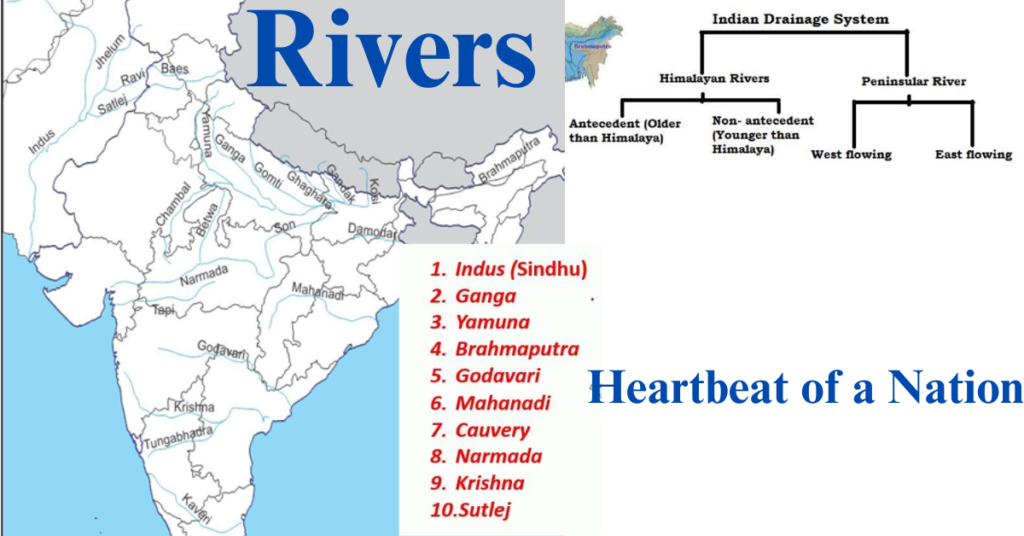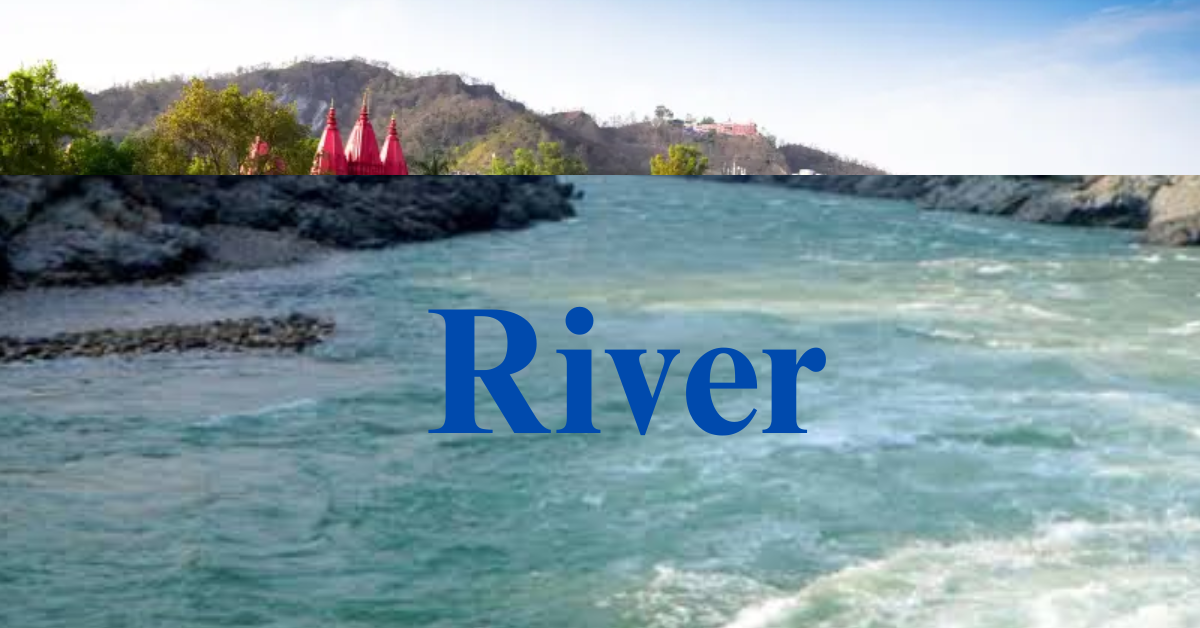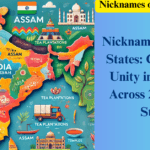
India’s Rivers: The Heartbeat of a Nation
Table of Contents
Rivers of India: The Heartbeat of a Nation .India, is a land of many riversand known for its diverse landscapes and rich cultural heritage, iscomplicated woven together by its vast network of rivers. These rivers are not merely geographical features; they are the lifelines of the nation, sustaining millions of lives and nurturing the land. From the majestic and pure Himalayan rivers in the north to the peninsular rivers in the south, each river has its unique story, significance, and challenges. In This article we explores the major rivers of India, highlighting their origins, courses, tributaries, and the vital roles they play in the country’s ecosystem and civilization.
The Himalayan Rivers
The Ganga or Ganges
The Ganges, or Ganga, is the most respected river in India. Originating from the Gangotri Glacier in Uttarakhand, it flows for over 2,500 kilometers through the northern plains before emptying into the Bay of Bengal. Along its course, the Ganges nurtures some of the most fertile lands, supporting the livelihoods of millions.According to religious point of view ganga river has very respectful place for hindus heart and does not complete any religious ceremone without the pure and holy water of Ganga.According to Hindu beliefs, the river Ganga is also called Mokshadayini, hence the holy water of Ganga is used from birth to death.A lot of scientific research has been done on Ganga water and certain elements are found in it which never allow the water to become polluted.The water of Ganga does not get spoiled even after being kept for years, its purity always remains intact.
Major Tributaries:
- Yamuna: Originating from the Yamunotri Glacier, it merges with the Ganges at Allahabad (Prayagraj), forming the sacred Triveni Sangam.
- Ghaghara: Rising in Tibet, it joins the Ganges in Bihar.
- Son: Flowing from the Amarkantak Plateau, it meets the Ganges near Patna.
- Gandak: Originating in Nepal, it merges with the Ganges in Bihar.
The Ganges basin is crucial for agriculture, especially for crops like rice, wheat, and sugarcane. However, pollution remains a significant challenge, necessitating ongoing efforts to restore its purity and flow.
The Yamuna River
The Yamuna, a significant tributary of the Ganges, is also a sacred river. It originates from the Yamunotri Glacier in Uttarakhand and flows for approximately 1,376 kilometers, passing through major cities like Delhi, Mathura, and Agra before merging with the Ganges at Allahabad.
Major Tributaries:
- Chambal: Originating from the Vindhya Range, it joins the Yamuna in Uttar Pradesh.
- Betwa: Rising in Madhya Pradesh, it meets the Yamuna near Hamirpur.
- Ken: Originating in Madhya Pradesh, it merges with the Yamuna in Uttar Pradesh.
The Yamuna is vital for water supply in the National Capital Region and for agriculture in the surrounding areas. However, severe pollution, particularly in its stretch through Delhi, poses a significant threat to its health and sustainability.
The Brahmaputra River
The Brahmaputra, one of India’s major rivers, originates from the Angsi Glacier in Tibet as the Yarlung Tsangpo. Entering India through Arunachal Pradesh, it flows through Assam as the Brahmaputra before entering Bangladesh.
Major Tributaries:
- Subansiri: Originating in Tibet, it joins the Brahmaputra in Assam.
- Manas: Rising in Bhutan, it merges with the Brahmaputra in Assam.
- Dibang: Flowing from Arunachal Pradesh, it meets the Brahmaputra in Assam.
- Lohit: Also originating in Tibet, it joins the Brahmaputra in Assam.
The Brahmaputra basin is characterized by vast floodplains, rich biodiversity, and annual flooding that impacts the inhabitants of Assam and neighboring regions.
The Peninsular Rivers
The Godavari River
The Godavari, often called the Dakshina Ganga (Ganges of the South), is the longest river in peninsular India. It originates from the Trimbak Plateau in Maharashtra and flows eastward for about 1,465 kilometers before emptying into the Bay of Bengal.
Major Tributaries:
- Pravara: Originating in Maharashtra, it joins the Godavari near Pravarasangam.
- Manjira: Rising in the Balaghat Range, it meets the Godavari near Basar.
- Indravati: Originating in Odisha, it merges with the Godavari in Telangana.
- Sabari: Flowing from Odisha, it joins the Godavari in Andhra Pradesh.
The Godavari basin supports extensive agriculture and hydroelectric projects, making it an economic lifeline for the states it traverses. However, water sharing disputes among riparian states pose challenges to its management.
The Krishna River
The Krishna River originates from the Mahabaleshwar Plateau in Maharashtra and flows for about 1,400 kilometers through Karnataka, Telangana, and Andhra Pradesh before reaching the Bay of Bengal.
Major Tributaries:
- Bhima: Originating in Maharashtra, it is a major tributary that joins the Krishna in Karnataka.
- Tungabhadra: Formed by the confluence of the Tunga and Bhadra rivers in Karnataka, it merges with the Krishna in Andhra Pradesh.
- Koyna: Rising in the Western Ghats, it meets the Krishna in Maharashtra.
- Ghataprabha: Originating in Karnataka, it joins the Krishna in the same state.
The Krishna basin is vital for irrigation and hydropower, supporting extensive agricultural activities. However, it faces challenges related to water sharing disputes and over-extraction.
The Kaveri River
The Kaveri River, revered in South Indian culture, originates from the Brahmagiri Hills in Karnataka and flows for about 800 kilometers through Karnataka and Tamil Nadu before reaching the Bay of Bengal.
Major Tributaries:
- Hemavati: Originating in the Western Ghats, it joins the Kaveri in Karnataka.
- Kabini: Rising in Kerala, it meets the Kaveri in Karnataka.
- Bhavani: Flowing from the Nilgiri Hills, it merges with the Kaveri in Tamil Nadu.
- Amaravati: Originating in the Anamalai Hills, it joins the Kaveri in Tamil Nadu.
The Kaveri basin is known for its rich agricultural fields and supports numerous hydroelectric projects. Water sharing disputes between Karnataka and Tamil Nadu have been a long-standing issue, requiring judicial and governmental interventions.
Western and Eastern Flowing Rivers
The Narmada River
The Narmada River, one of the major rivers of central India, originates from the Amarkantak Plateau in Madhya Pradesh and flows westward for about 1,312 kilometers before emptying into the Arabian Sea.
Major Tributaries:
- Banjar: Originating in Madhya Pradesh, it is a significant tributary of the Narmada.
- Tawa: Rising in the Satpura Range, it joins the Narmada in Madhya Pradesh.
- Hiran: Flowing from Madhya Pradesh, it meets the Narmada near Jabalpur.
- Shakkar: Also originating in Madhya Pradesh, it merges with the Narmada near Khandwa.
The Narmada basin supports agriculture, industry, and several large hydroelectric projects, including the Sardar Sarovar Dam. The river is also revered in Hindu mythology and attracts numerous pilgrims.
The Tapti River
The Tapti River, flowing parallel to the Narmada, originates from the Satpura Range in Madhya Pradesh and flows westward for about 724 kilometers before reaching the Arabian Sea.
Major Tributaries:
- Purna: Originating in Madhya Pradesh, it is a major tributary of the Tapti.
- Betul: Rising in the Satpura Range, it joins the Tapti in Madhya Pradesh.
- Anjan: Flowing from the Satpura Range, it meets the Tapti near Betul.
The Tapti basin supports agriculture and industry, particularly in the states of Madhya Pradesh, Maharashtra, and Gujarat. The river also faces challenges related to water pollution and over-extraction.
Challenges and Conservation Efforts
The rivers of India, while crucial to the country’s sustenance, face numerous challenges. Pollution from industrial discharge, agricultural runoff, and domestic sewage poses severe threats to water quality. Over-extraction of water for irrigation and urban needs leads to declining water levels, affecting the ecological balance and availability for future generations.
To address these challenges, the Indian government has initiated several conservation efforts:
- Namami Gange: Launched in 2014, this program aims to clean and rejuvenate the Ganges through projects focused on sewage treatment, riverfront development, and biodiversity conservation.
- National River Conservation Plan: This plan extends to various rivers across the country, aiming to reduce pollution and improve water quality through infrastructure development and public awareness campaigns.
- Interlinking of Rivers: This ambitious project aims to connect major rivers to balance water distribution and mitigate floods and droughts, though it faces environmental and logistical challenges.
Conclusion
The rivers of India are more than just water bodies; Rivers are the Heartbeat of a Nation, supporting its agriculture, industry, and cultural heritage. As India progresses, the sustainable management and conservation of its rivers will be crucial to ensuring a balanced and prosperous future. The collective efforts of the government, communities, and individuals will determine the health and vitality of these precious waterways for generations to come.We all should take a pledge today to save our rivers which are the source of our life, otherwise in the coming time all these will get extinct and with this the human race will also get extinct.Because water is life and without water it is impossible to survive on earth


